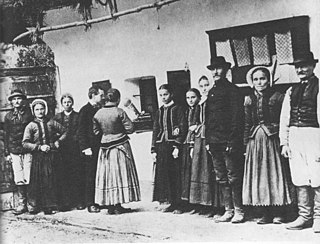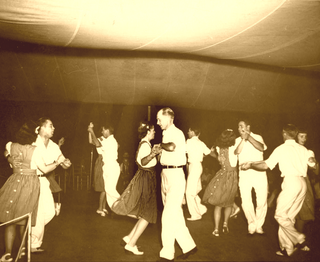
Folk music includes traditional folk music and the genre that evolved from it during the 20th-century folk revival. Some types of folk music may be called world music. Traditional folk music has been defined in several ways: as music transmitted orally, music with unknown composers, or music performed by custom over a long period of time. It has been contrasted with commercial and classical styles. The term originated in the 19th century, but folk music extends beyond that.

A square dance is a dance for four couples arranged in a square, with one couple on each side, facing the middle of the square. Square dances were first documented in 16th-century England but were also quite common in France and throughout Europe. They came to North America with the European settlers and have undergone considerable development there. In some countries and regions, through preservation and repetition, square dances have attained the status of a folk dance. The Western American square dance may be the most widely known form worldwide, possibly due to its association in the 20th century with the romanticized image of the American cowboy. Square dancing is, therefore, strongly associated with the United States. Nineteen U.S. states have designated it as their official state dance.

Ethnomusicology is the study of music from the cultural and social aspects of the people who make it. It encompasses distinct theoretical and methodical approaches that emphasize cultural, social, material, cognitive, biological, and other dimensions or contexts of musical behavior, instead of only its isolated sound component.
The music of a United States reflects the country's pluri-ethnic population through a diverse array of styles. It is a mixture of music influenced by West African, Irish, Scottish and mainland European cultures among others. The country's most internationally renowned genres are jazz, blues, country, bluegrass, rock, rhythm and blues, soul, ragtime, hip hop, doo wop, pop, techno, house, folk music, disco, boogaloo, reggaeton, and salsa. American music is heard around the world. Since the beginning of the 20th century, some forms of American popular music have gained a near-global audience.
The term American folk music encompasses numerous music genres, variously known as traditional music, traditional folk music, contemporary folk music, or roots music. Many traditional songs have been sung within the same family or folk group for generations, and sometimes trace back to such origins as Great Britain, Europe, or Africa. Musician Mike Seeger once famously commented that the definition of American folk music is "...all the music that fits between the cracks."
The music of Barbados includes distinctive national styles of folk and popular music, including elements of Western classical and religious music. The culture of Barbados is a syncretic mix of African and British elements, and the island's music reflects this mix through song types and styles, instrumentation, dances, and aesthetic principles.
Themusic of Italy has traditionally been one of the cultural markers of Italian national and ethnic identity and holds an important position in society and in politics. Italian music innovation – in musical scale, harmony, notation, and theatre – enabled the development of opera, in the late 16th century, and much of modern European classical music – such as the symphony and concerto – ranges across a broad spectrum of opera and instrumental classical music and popular music drawn from both native and imported sources.
Indigenous music of North America, which includes American Indian music or Native American music, is the music that is used, created or performed by Indigenous peoples of North America, including Native Americans in the United States and Aboriginal peoples in Canada, Indigenous peoples of Mexico, and other North American countries—especially traditional tribal music, such as Pueblo music and Inuit music. In addition to the traditional music of the Native American groups, there now exist pan-tribal and intertribal genres as well as distinct Native American subgenres of popular music including: rock, blues, hip hop, classical, film music, and reggae, as well as unique popular styles like chicken scratch and New Mexico music.
Indigenous music of Canada encompasses a wide variety of musical genres created by Aboriginal Canadians. Before European settlers came to what is now Canada, the region was occupied by many First Nations, including the West Coast Salish and Haida, the centrally located Iroquois, Blackfoot and Huron, the Dene to the North, and the Innu and Mi'kmaq in the East and the Cree in the North. Each of the indigenous communities had their own unique musical traditions. Chanting – singing is widely popular and most use a variety of musical instruments.
Industrial folk music, industrial folk song, industrial work song or working song is a subgenre of folk or traditional music that developed from the 18th century, particularly in Britain and North America, with songs dealing with the lives and experiences of industrial workers. The origins of industrial folk song are in the British industrial revolution of the eighteenth century as workers tended to take the forms of music with which they were familiar, including ballads and agricultural work songs, and adapt them to their new experiences and circumstances. They also developed in France and the US as these countries began to industrialise.

Cantometrics is a method developed by Alan Lomax and a team of researchers for relating elements of the world's traditional vocal music to features of social organization as defined via George Murdock's Human Relations Area Files, resulting in a taxonomy of expressive human communications style. Lomax defined Cantometrics as the study of singing as normative expressive behavior and maintained that Cantometrics reveals folk performance style to be a "systems-maintaining framework" which models key patterns of co-action in everyday life. His work on Cantometrics gave rise to further comparative studies of aspects of human communication in relation to culture, including: Choreometrics, Parlametrics, Phonotactics, and Minutage.

The American Folklife Center at the Library of Congress in Washington, D.C. was created by Congress in 1976 "to preserve and present American Folklife". The center includes the Archive of Folk Culture, established at the Library in 1928 as a repository for American folk music. The center and its collections have grown to encompass all aspects of folklore and folklife worldwide.
Pueblo music includes the music of the Hopi, Zuni, Taos Pueblo, San Ildefonso, Santo Domingo, and many other Puebloan peoples, and according to Bruno Nettl features one of the most complex Native American musical styles on the continent. Characteristics include common use of hexatonic and heptatonic scales, variety of form, melodic contour, and percussive accompaniment, melodic range averaging between an octave and a twelfth, with rhythmic complexity equal to the Plains Indians musical sub-area.
Italian folk music has a deep and complex history. National unification came quite late to the Italian peninsula, so its many hundreds of separate cultures remained un-homogenized until quite recently compared to many other European countries. Moreover, Italian folk music reflects Italy's geographic position at the south of Europe and in the center of the Mediterranean Sea: Arabic, African, Celtic, Persian, and Slavic influences are readily apparent in the musical styles of the Italian regions. Italy's rough geography and the historic dominance of small city states has allowed quite diverse musical styles to coexist in close proximity.
Texas Gladden (1894–1967) was an American folk singer, best known for her traditional Appalachian ballad style of singing, which she began to record in the 1930s.
"Rock Island Line" is an American folk song. Ostensibly about the Chicago, Rock Island and Pacific Railroad, it appeared as a folk song as early as 1929. The first recorded performance of "Rock Island Line" was by inmates of the Arkansas Cummins State Farm prison in 1934.











